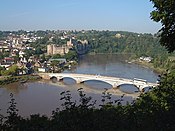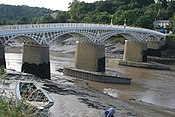Old Wye Bridge, Chepstow
Old Wye Bridge | |
|---|---|
 | |
| Coordinates | 51°38′47″N 2°40′19″W / 51.646306°N 2.671944°W |
| Crosses | River Wye |
| Locale | Chepstow, Monmouthshire Tutshill, Gloucestershire |
| Characteristics | |
| Material | Cast iron, stone |
| Total length | 106 metres (116 yd) |
| No. of spans | 5 |
| History | |
| Designer | John Rastrick |
| Construction end | 1816 |
| Replaces | Earlier, wooden bridge |
| Location | |
 | |
The Old Wye Bridge or Town Bridge at Chepstow, also known historically as Chepstow Bridge, crosses the River Wye between Monmouthshire in Wales and Gloucestershire in England, close to Chepstow Castle. Although there had been earlier wooden bridges on the site since Norman times, the current road bridge was constructed of cast iron in 1816 during the Regency period, by John Rastrick of Bridgnorth, who greatly modified earlier plans by John Rennie.
The bridge crosses a river with one of the highest tidal ranges in the world. It carried the main A48 road between Newport and Gloucester until 1988, when a new road bridge was opened downstream alongside Chepstow Railway Bridge. The road bridge now carries local traffic between Chepstow and Tutshill. It is a Grade I listed building.
Earlier structures
Before

After the
Neglect continued, however, and in 1605 it was said that the bridge was again "broken, fallen down and quite carried away with the Stream... whereby the said Passage and Highway is utterly taken away..."[1] Under new legislation that year it was agreed that the bridge be maintained by a special "bridge money" tax levied on the residents of the two counties. For the next two centuries each county appointed a surveyor responsible for either end of the bridge.[4] Apart from one stone pier in the centre, the bridge was entirely built of wood. The bridge was purposely destroyed by the Royalists during the Civil War in 1644, but was rebuilt by 1647. It was seriously damaged by storms in 1703, and again by high water in 1738, but was repaired both times. William Cole wrote of the bridge in 1746 that it was "the lightest in England, and the highest from the water."[1] A suggestion in 1768 that the two counties should share the cost of building a new bridge failed because Monmouthshire – a smaller and less prosperous county than Gloucestershire – considered it unreasonable that it should pay half the cost.[1] However, in 1785, the wooden piers on the Monmouthshire side were rebuilt as four stone arches, although the Gloucestershire half remained timber until 1815.[3]
The 1816 bridge
In 1810 the bridge was again declared to be "in decay" and dangerous, and local magistrates commissioned engineer John Rennie, the architect of Waterloo Bridge in London, to design a new bridge. Rennie's designs, at an estimated cost of £41,890 (equivalent to £3,750,000 in 2023),[5] were considered to be too expensive, but action was eventually taken after a ship collided with the wooden bridge in 1812, demolishing part of it and causing six deaths.[1][6] The foundation stone for the new bridge was laid on 13 April 1813.[6] In 1814 the contract to build the bridge was let to the Bridgnorth firm of Hazeldine, Rastrick & Co., at a cost of £17,850, less than half that of Rennie's estimate.[7]
The bridge was designed by John Rastrick, in a style apparently inspired by the work of Thomas Telford.[6] It was made of cast iron in five arches, cast at Bridgnorth, with a centre span of 34 metres (112 ft), intermediate spans of 21 metres (69 ft), and outer spans of 10 metres (33 ft).[8] The bridge was opened on 24 July 1816, with an elaborate ceremony.[3]
The bridge is the largest iron arch road bridge remaining from the first half-century of iron and steel construction, before the technological innovation of suspension bridges.[6] It is described by architectural historian John Newman as "a supremely elegant composition of five shallow segmental lattice arches carrying the gently curved roadway... This superstructure rests on reassuringly strong tapering piers of squared ashlar...".[9] Ornate ironwork on the bridge marks the boundary point between the two counties of Gloucester and Monmouth. The cast iron lamp posts were bought from Sheffield City Council and installed in 1969.[2] The bridge is a Grade I listed building.[a][10]
Carrying the main road between Gloucester and South Wales, the bridge became a notorious bottleneck and was strengthened several times. The bridge was first strengthened in 1889,[1] and there were major structural repairs in 1979.[12] It was superseded, except for local traffic, by the A48 road bridge opened in January 1988.[13]
The bridge now carries local traffic on the unclassified road between Chepstow and
See also
Gallery
-
A view of the bridge, c.1820
-
The bridge and Chepstow Castle, viewed from Tutshill
-
Low tide
-
An abnormally high tide
-
Decorative ironwork in the centre of the bridge, showing the Monmouthshire-Gloucestershire boundary line
Notes
References
- ^ ISBN 0-906134-09-9.
- ^ ISBN 0-900278-12-9.
- ^ a b c Ivor Waters (1955). Chepstow Parish Records.
- ISBN 1-904396-52-6, p.212
- ^ UK Retail Price Index inflation figures are based on data from Clark, Gregory (2017). "The Annual RPI and Average Earnings for Britain, 1209 to Present (New Series)". MeasuringWorth. Retrieved 7 May 2024.
- ^ a b c d Burrows, John (2015). Chepstow Bridge (PDF). Chepstow Town Council.
- ^ Taylor, Robert (1854). Taylor's illustrated guide to the banks of the Wye. Taylor. p. 24.
- ^ Structurae: Chepstow Bridge. Structurae.net. Accessed 12 February 2012
- ISBN 0-14-071053-1, p.184
- ^ National Historic Assets of Wales. Retrieved 16 April 2022.
- ^ Historic England. "Chepstow Bridge (Grade I) (1101561)". National Heritage List for England. Retrieved 31 January 2024.
- ^ a b Katharine Skellon, "Bid for World Heritage Status for iconic bridge", South Wales Argus, 27 September 2015. Retrieved 6 October 2015
- ^ Chepstow Town Council: Town Trail Archived 30 May 2010 at the Wayback Machine. Accessed 16 February 2012
- ^ BBC News, "Chepstow Bridge's 200 year-old crossing celebrated", 24 July 2016. Retrieved 24 July 2016





